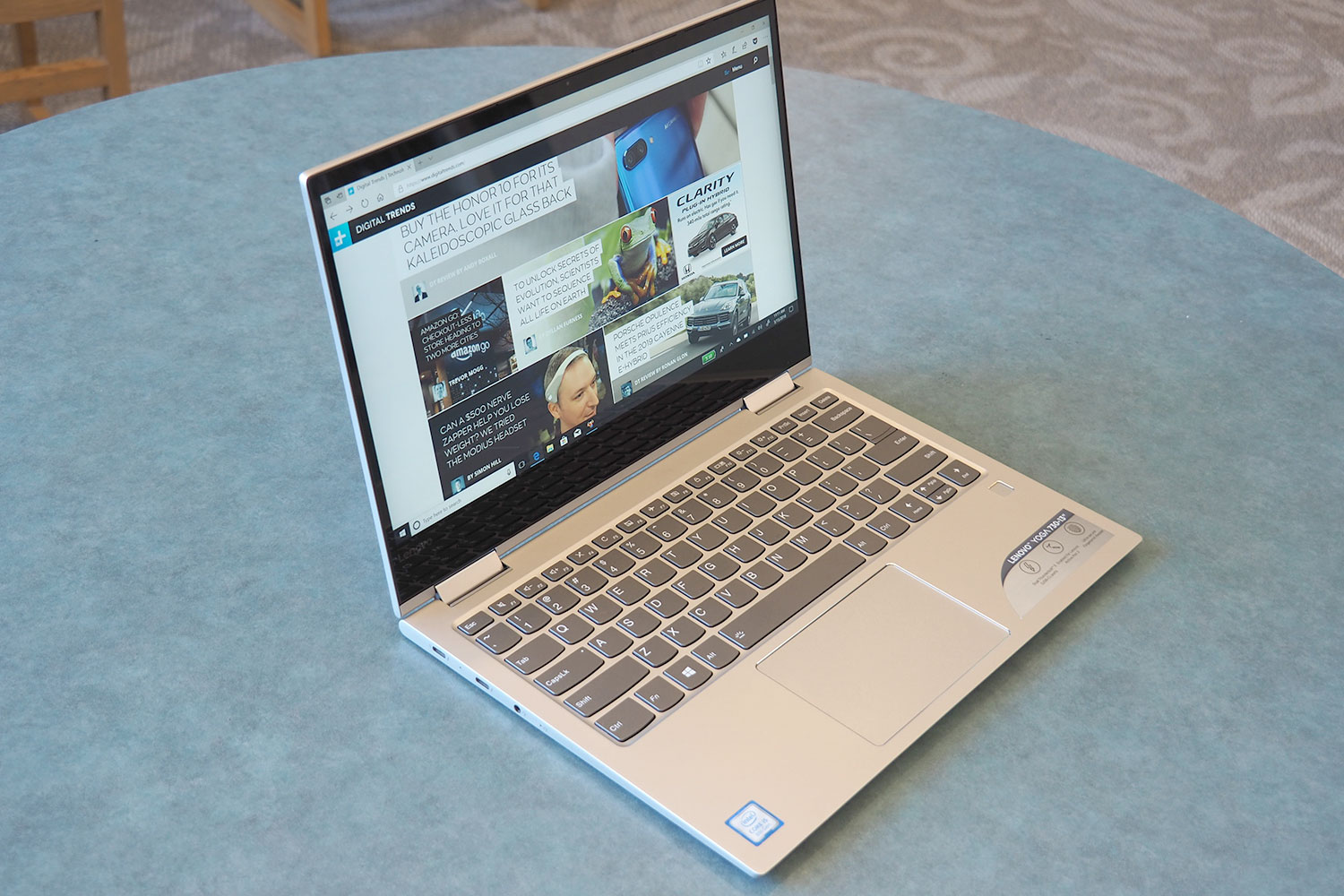
There was a time when you needed to spend $1,000 or more to guarantee a good notebook experience. Budget and midrange machines tended to be poorly built, underpowered, and to offer terrible battery life. It’s safe to say that the pendulum has swung in the other direction, and today some great notebook options come in for less than a grand.
Even better, that includes convertible 2-in-1s, which let you swivel the display around from clamshell to tablet modes, with a couple of useful modes in between. Two good examples are the new Acer Spin 5 and the Lenovo Yoga 730, with both offering Intel’s 8th-generation Core processors and Full HD 13.3-inch displays. Acer has a trick up its sleeve, though, shipping the Spin 5 with Alexa enabled out of the box. Is that enough to give it an edge over the Yoga 730?
Design

The Yoga 730 utilizes Lenovo’s recent conservative, businesslike design aesthetic, with a silver-gray chassis that’s attractive but doesn’t attract attention. If you can accept its fade-into-the-background demeanor, then you’ll be rewarded with solid build quality, a functional convertible hinge, and a thin (0.62 inches) and light (2.47 pounds) chassis. And if you want to avoid stares at your favorite cafe, then the Yoga 730 is for you.
Acer’s Spin 5 matches this conservative design philosophy. It sports a dark gray color with minimal adornment, with some fine metallic hatching on the lid and some chrome trim adding just a touch of flair. The Spin 5 is also built well, with minimal bending and flexing and with a hinge that does its job of holding the display in the right position. Its downfall: some huge bezels that look comical next to the Yoga 730’s slimmer versions. That makes the Spin 5 wider, deeper, and heavier (3.31 pounds), although it’s close to the same thickness at 0.63 inches.
We’ll note here that both Lenovo and Acer are offering Amazon Alexa support on some of their newer notebooks. The Yoga 730 and Spin 5 both qualify, but only the latter has
Had Acer built in smaller bezels and thus minimized the Spin 5’s dimensions, then it would be in a close tie with the Yoga 730 when it comes to the design.
Performance

As is the case with the vast majority of thin and light notebooks today, both the Spin 5 and the Yoga 730 utilized Intel’s quad-core 8th-generation CPUs. That promises excellent productivity performance, on demand, balanced against some impressive efficiency. Unsurprisingly, these two 2-in-1s are very similar performers with regard to their processors. In terms of storage speeds, the Yoga 730 wins out thanks to its faster PCIe solid-state disk (SSD) compared to the Spin 5’s SATA version.
There are also some slight differences regarding their displays. They each offer Full HD (1,920 x 1,080 or 166 PPI) 13.3-inch IPS panels, both of which are a bit dim at less than 300 nits. The Spin 5, though, offers higher contrast (but still less than we’d like to see), a wider color gamut, better color accuracy, and a perfect gamma (so video is neither too light nor too dark). That beats out the Yoga 730 on all counts, making the Spin 5’s display a more pleasant overall experience.
Neither Acer nor Lenovo offer 4K UHD display options, which is a shame. Full HD at this screen size is okay, but pixel-peepers and Netflix watchers would benefit from a higher resolution alternative.
Portability

As we’ve already covered, the Yoga 730 is smaller than the Spin 5 thanks to its modern bezels, and it’s also lighter. That makes Lenovo’s 2-in-1 easier to carry around, although the Spin 5 is almost as thin and so doesn’t take up too much space in a backpack. You’ll be more comfortable using the Yoga 730 in tablet mode, and so consider if that’s important to you.
At the same time, Acer packed a larger battery into the Spin 5 (54 watts versus 48 watts), and managed to optimize things to overcome the Core i7-8550U as compared to the Core i5-8250U in our Yoga 730 review unit. We found the Spin 5 to last longer in all of our battery tests, from running a CPU-intensive web benchmark, to browsing a variety of web sites, to looping a local video. In fact, the Spin 5 lasted more than an hour longer in all but the most intensive test, meaning that it will keep you working for longer away from a charge than the Yoga 730 when getting work done.
The Yoga 730 is slightly smaller and lighter than the Spin 5, but its lesser battery life mitigates that advantage.
Acer’s Spin 5 wins out

The Lenovo Yoga 730 costs $850 for a Core i5-8250U, 8GB of RAM, and a 256GB PCIe SSD. That compares to $900 for the Spin 5’s Core i7-8550U, 8GB of RAM, and 256GB SATA SSD. In other words, they’re close enough in price that it’s a wash.
But the Spin 5 wins out, primarily because it offers better battery life to go with its great performance. Having Alexa enabled out of the box isn’t a huge advantage, but it might sway things as well for fans of Amazon’s digital assistant.
Editors' Recommendations
- Dell XPS vs. Dell Latitude: here’s how to decide
- Best Lenovo laptop deals: Save on Yoga and ThinkPad laptops
- The best laptops for kids, tested and selected by experts
- Why the latest ThinkPad X1 Yoga Gen 8 isn’t worth the upgrade
- HP’s new Envy x360 14 looks like a killer value for what you get


